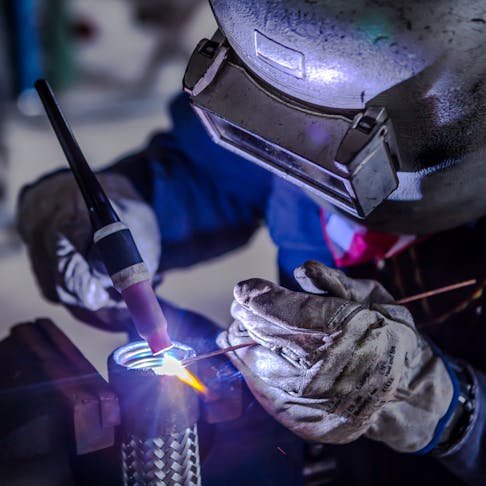Advanced Welding WPS: Customizing Requirements for Complicated Jobs
The Ultimate Overview to Welding WPS Procedures: A Thorough Summary for Welders
In the detailed world of welding, Welding Procedure Specs (WPS) act as the backbone of guaranteeing high quality, consistency, and safety and security in welding procedures. Comprehending the nuances of developing, applying, and monitoring WPS treatments is crucial for welders wanting to boost their craft and meet market standards. As we look into the various parts of a WPS and discover the details of credentials and certification, we will certainly uncover the important role these treatments play in the world of welding. Allow's begin on a journey to untangle the complexities and importance of WPS procedures in welding techniques.
Relevance of WPS Procedures
Recognizing the relevance of Welding Procedure Specifications (WPS) treatments is critical for guaranteeing the high quality and integrity of welded structures. WPS treatments work as a roadmap for welders, detailing the required steps, criteria, and products required to attain an audio weld. By adhering to WPS guidelines, welders can ensure consistency in their job, resulting in structurally audio and trusted welds.
One of the main factors why WPS procedures are vital is their duty in maintaining weld high quality and integrity. Complying with the defined welding parameters and methods laid out in the WPS aids avoid flaws such as porosity, splitting, or insufficient blend, which can compromise the strength and toughness of the weld.

Parts of a WPS
A Welding Procedure Requirements (WPS) usually comprises essential elements that detail the certain requirements for performing a weld, ensuring uniformity and quality in the welding procedure. The crucial components of a WPS consist of crucial variables such as base metals, filler steels, preheat and interpass temperature levels, welding procedures, shielding gases, welding settings, and post-weld warmth therapy requirements.
Base steels refer to the products being joined, while filler metals are used to fill the space between the base metals during welding. The welding procedure outlines the particular method to be used, whether it's gas steel arc welding (GMAW), shielded metal arc welding (SMAW), or one more approach. Welding placements specify the orientations in which welding can be carried out.

Qualification and Accreditation
Having established the important elements of a Welding Procedure Spec (WPS), the focus now moves towards the essential aspects of certification and qualification in welding practices.

Qualification, on the other hand, is the official recognition of a welder's certifications by a relevant accreditation body or organization. Welding qualifications are normally based on the particular welding procedures, materials, and settings a welder is certified to collaborate with. Holding a valid welding certification shows that a welder fulfills industry standards and is qualified to carry out welding jobs to the needed specs.
Developing a WPS
To create a Welding Procedure Spec (WPS) that meets sector standards, cautious factor to consider of welding procedures, materials, and functional specifications is necessary. The very first action in producing a WPS is to determine the welding process to be used, such as gas metal arc welding (GMAW) or secured steel arc welding (SMAW)

Applying and Monitoring WPS
Upon wrapping up the thorough Welding Treatment Specification (WPS) that diligently details welding procedures, products, functional parameters, and top quality assurance actions, the emphasis changes to successfully executing and checking the well-known treatments. Implementation entails making sure that all welders associated with the task know with the WPS and follow it diligently during the welding procedure. This calls for giving sufficient training and supervision to ensure adherence to the defined treatments. Checking the WPS involves constant oversight to verify that welding activities line up with the recorded specifications. Assessments, testing, and high quality control procedures are necessary components of the monitoring procedure to determine any type of inconsistencies or issues promptly. Regular audits and evaluations of the welding treatments help in keeping uniformity and high quality throughout the job. Efficient execution and surveillance of the WPS are essential for making certain the integrity, strength, and security of view it the bonded joints, inevitably adding to the overall success of the welding project.
Conclusion
To conclude, understanding and adhering to Welding Procedure Specifications (WPS) is important for welders to make certain high quality, uniformity, and security in their job. By recognizing the parts of a WPS, obtaining correct certifications and accreditations, producing detailed treatments, and implementing and monitoring them effectively, welders can boost their skills and effectiveness in welding methods. Sticking to WPS treatments is essential for generating top quality welds and conference sector requirements.
In the elaborate globe of welding, Welding Treatment Specifications (WPS) serve as the backbone of making certain quality, uniformity, and security their website in welding procedures. The welding process details the specific technique to be made use of, whether it's gas steel arc welding (GMAW), secured steel arc welding (SMAW), or one more approach.To develop a Welding Procedure Requirements (WPS) that fulfills sector requirements, mindful factor to consider of welding processes, materials, and functional specifications is essential. The first action in developing a WPS is to recognize the welding process to be utilized, such as gas metal arc welding (GMAW) or secured metal arc welding (SMAW)Upon settling the thorough Welding Procedure Specification (WPS) that meticulously details welding procedures, materials, functional criteria, and top quality guarantee measures, the emphasis shifts to effectively implementing and checking the well-known procedures.